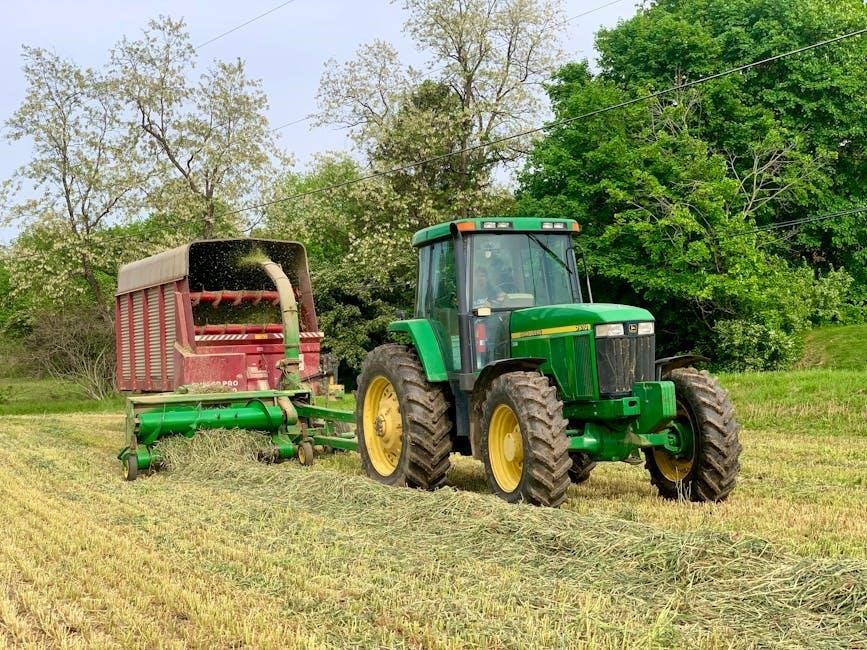john deere lt155 owners manual
The John Deere LT155 Owner’s Manual provides essential guidance for operating and maintaining this reliable lawn tractor, produced from 1998 to 2001. Designed for homeowners, it ensures optimal performance and longevity by detailing safe operation, maintenance, and troubleshooting. Referencing this manual is crucial for understanding the 15 HP Kohler engine’s capabilities and proper care procedures.
Overview of the John Deere LT155 Lawn Tractor
The John Deere LT155 is a compact lawn tractor designed for residential use, offering reliable performance for mowing and light landscaping tasks. Manufactured from 1998 to 2001 in Horicon, Wisconsin, it features a 15 horsepower (11.2 kW) single-cylinder, air-cooled Kohler CV15S gasoline engine with a 426 cc displacement. This tractor is ideal for homeowners seeking a durable and efficient solution for maintaining smaller to medium-sized lawns; With its straightforward design and user-friendly controls, the LT155 provides a comfortable and productive mowing experience, making it a popular choice for those who value simplicity and effectiveness in lawn care.
Importance of Reading the Owner’s Manual
Reading the John Deere LT155 Owner’s Manual is crucial for safe and effective operation. It provides detailed instructions on proper usage, maintenance, and troubleshooting, ensuring optimal performance and longevity. The manual highlights safety precautions to prevent accidents and outlines essential maintenance routines to keep the tractor in top condition. By understanding the manual, users can avoid costly repairs and ensure compliance with warranty terms. It also serves as a comprehensive guide for diagnosing issues and performing repairs. Whether you’re a seasoned user or a new owner, the manual is an invaluable resource for maximizing efficiency and safety while operating the LT155.

Engine Specifications and Features
The John Deere LT155 is powered by a 15 HP Kohler CV15S single-cylinder, air-cooled gasoline engine, offering reliable performance with a 426 cc displacement, ideal for light landscaping tasks.
Engine Type and Performance
The John Deere LT155 features a Kohler CV15S single-cylinder, air-cooled gasoline engine, delivering 15 horsepower (11.2 kW) with a 426 cc displacement. This engine is designed for efficient operation, providing consistent power for mowing and light landscaping. Its compact design ensures reliability and durability, making it suitable for residential use. The engine’s air-cooled system enhances simplicity and reduces maintenance needs, while its single-cylinder configuration ensures fuel efficiency. Overall, the Kohler CV15S engine in the LT155 balances performance and reliability, making it a trusted choice for homeowners seeking dependable lawn care equipment.
Fuel and Oil Requirements
The John Deere LT155 requires regular unleaded gasoline with an octane rating of 87 or higher for optimal performance. The fuel tank capacity is approximately 2.5 gallons. For engine oil, use SAE 30 or 10W-30 synthetic oil, ensuring compatibility with the Kohler CV15S engine. Regular oil changes are essential, with the recommended oil filter being part number AM125424. Always refer to the owner’s manual for specific guidelines on fuel and oil specifications to maintain engine health and prevent damage. Proper adherence to these requirements ensures efficient operation and extends the lifespan of the tractor.

Maintenance Schedule and Procedures
Regular maintenance is crucial for the John Deere LT155. Follow the recommended schedule for oil changes, air filter cleaning, and blade sharpening. Replace the oil filter (AM125424) and fuel filter (AM107314) every 50 hours. Inspect and replace belts and spark plugs as needed. Refer to the manual for detailed procedures to ensure optimal performance and longevity of your tractor.
Regular Maintenance Tasks
Regular maintenance ensures the John Deere LT155 operates efficiently and prolongs its lifespan. Change the engine oil (TY22076) and replace the oil filter (AM125424) every 50 hours. Clean or replace the air filter (GY20574) as needed. Inspect and replace the fuel filter (AM107314) every 100 hours. Check tire pressure monthly and maintain the recommended levels. Sharpen or replace mower blades seasonally to ensure clean cuts. Lubricate moving parts and inspect belts for wear. Refer to the manual for a detailed schedule and specific part numbers to ensure proper maintenance and avoid costly repairs. Regular upkeep keeps your tractor running smoothly.
Recommended Service Intervals
Adhere to the recommended service intervals to maintain your John Deere LT155’s performance and longevity. Change the engine oil (TY22076) and oil filter (AM125424) every 50 hours of operation. Replace the fuel filter (AM107314) every 100 hours to ensure proper fuel flow. Clean or replace the air filter (GY20574) as needed, typically every 100 hours. Inspect and sharpen mower blades seasonally, and check tire pressure monthly. Schedule a comprehensive inspection annually, including mower deck alignment and belt checks. Refer to the manual for a detailed maintenance schedule to prevent wear and tear, ensuring your tractor remains reliable and efficient. Regular servicing prevents costly repairs. Always use genuine John Deere parts for optimal results. Follow these intervals to keep your LT155 in peak condition..

Safety Guidelines and Precautions
Always follow safety guidelines to ensure safe operation of your John Deere LT155. Avoid bodily injury by using proper tools and inspecting equipment regularly. Prevent fires by storing flammable fluids safely and avoiding sparks. Ensure all hardware is secure before operation. Refer to the manual for detailed safety precautions to protect yourself and others while operating the tractor. Regular inspections and adherence to safety protocols are essential for a safe and efficient mowing experience. Proper maintenance and care reduce accident risks. Always prioritize safety when handling fuel and performing repairs. Keep loose clothing tied back and avoid distractions while operating the tractor. Never leave children unattended near the equipment. Proper ventilation is crucial when working in enclosed spaces to prevent carbon monoxide buildup. Be cautious on uneven terrain and avoid sudden turns to maintain stability. Keep the tractor well-lit when operating in low-light conditions. Use only genuine John Deere parts to ensure compatibility and safety. Familiarize yourself with emergency shutdown procedures. Stay alert and avoid overexertion while operating the tractor. Keep the mower deck clear of debris to prevent accidental projectiles. Avoid operating the tractor during extreme weather conditions. Ensure all guards and protective covers are in place before use. Never modify the tractor without consulting the manual or a professional. Keep emergency contact information nearby. Always shut off the engine and allow it to cool before performing any maintenance. Be mindful of your surroundings to avoid collisions with obstacles or people. Use the correct lifting techniques when handling heavy parts or attachments. Keep the tractor on a level surface when performing routine maintenance. Dispose of used oil and filters responsibly to protect the environment. Stay informed about local safety regulations and ensure compliance. Always wear protective gear, such as gloves and safety glasses, when operating or servicing the tractor. Keep the operator’s manual readily available for quick reference. Be aware of your physical limitations and take breaks when necessary. Ensure all attachments are securely fastened before use. Never operate the tractor if under the influence of drugs or alcohol. Keep the tractor’s path clear of toys, tools, or other objects that could cause tripping or accidents. Familiarize yourself with the tractor’s controls and functions before starting. Avoid overloading the tractor beyond its recommended capacity. Keep the tractor’s brakes in good working condition to maintain control. Regularly check and maintain the tractor’s tires to ensure proper traction and stability. Be cautious when approaching slopes and use the recommended mowing pattern. Never operate the tractor in a way that could damage the environment or nearby structures. Stay updated on any recalls or safety notices related to your tractor model. Always follow the manufacturer’s recommendations for winter storage and preparation. Be prepared for emergencies by having a first aid kit nearby. Keep the tractor’s serial number and model information easily accessible for service requests. Avoid using the tractor in areas with standing water or where the ground is unstable. Use the correct hitch pins and ball sizes when towing attachments or trailers. Regularly inspect the tractor’s hydraulic systems for leaks or damage. Ensure the tractor is properly ventilated when stored in a garage or shed. Be aware of the weather forecast and avoid operating the tractor during thunderstorms. Keep the tractor’s electrical systems dry and free from corrosion. Avoid using the tractor near open flames or sparks, especially when handling fuel. Regularly clean the tractor to prevent dirt and debris from causing mechanical issues. Use the correct type and amount of grease when lubricating moving parts. Ensure the tractor’s muffler and exhaust systems are in good condition to prevent carbon monoxide poisoning. Never operate the tractor if any safety features are malfunctioning or disabled. Keep the tractor’s operator’s area clean and uncluttered to prevent distractions. Regularly check the tractor’s belts and hoses for signs of wear and replace them as needed. Be cautious when operating the tractor near roads or pedestrian areas. Use the correct fuel type and avoid mixing different fuels. Keep the tractor’s battery terminals clean and secure to ensure proper starting. Regularly inspect the tractor’s PTO (Power Take-Off) system for proper function and safety. Ensure the tractor’s deck lift system is functioning correctly to avoid accidental lowering. Be aware of the tractor’s blind spots and use mirrors or spotters when necessary. Keep the tractor’s seats and platforms in good condition to prevent falls. Avoid operating the tractor if you are fatigued or not feeling well. Use the correct tools and techniques when servicing the tractor to avoid injury. Regularly inspect the tractor’s tires for wear and ensure proper inflation. Be cautious when operating the tractor on steep slopes and use the recommended safety practices. Keep the tractor’s brakes adjusted properly to maintain control during operation. Ensure the tractor’s lights and signals are functioning correctly for visibility and safety; Avoid using the tractor in extreme temperatures without proper precautions. Regularly inspect the tractor’s steering system for wear and ensure proper alignment. Be aware of the tractor’s weight and avoid operating it on unstable surfaces. Keep the tractor’s operator’s manual in the glove compartment for easy access. Regularly check the tractor’s fluid levels and top them off as needed. Use the correct type of coolant and avoid mixing different types. Be cautious when handling sharp objects like blades and attachments. Keep the tractor’s work area well-lit to prevent accidents. Avoid operating the tractor if the safety interlocks are not functioning properly. Regularly inspect the tractor’s seat belts and ensure they are in good condition. Be aware of the tractor’s surroundings and avoid operating near children or pets. Keep the tractor’s emergency stop switch easily accessible and functional. Regularly inspect the tractor’s hydraulic lines for leaks or damage. Use the correct hitch pins and ball sizes when towing attachments or trailers. Be cautious when operating the tractor near water or wet surfaces. Keep the tractor’s electrical systems dry and free from corrosion. Regularly inspect the tractor’s muffler and exhaust systems for damage. Ensure the tractor’s battery is properly charged and maintained. Be aware of the tractor’s limitations and avoid overloading it. Keep the tractor’s operator’s area clean and free from debris. Regularly inspect the tractor’s belts and hoses for signs of wear. Use the correct type of grease when lubricating moving parts. Be cautious when operating the tractor near open flames or sparks. Keep the tractor’s tires in good condition and properly inflated. Regularly inspect the tractor’s brakes for wear and ensure proper function. Be aware of the tractor’s surroundings and avoid operating near obstacles. Keep the tractor’s seats and platforms in good condition to prevent falls. Use the correct tools and techniques when servicing the tractor. Regularly inspect the tractor’s steering system for wear and ensure proper alignment. Be cautious when operating the tractor on uneven terrain. Keep the tractor’s lights and signals functioning correctly for visibility. Regularly inspect the tractor’s hydraulic systems for leaks or damage. Be aware of the tractor’s weight and avoid operating it on unstable surfaces. Keep the tractor’s operator’s manual readily available for quick reference. Regularly check the tractor’s fluid levels and top them off as needed. Use the correct type of coolant and avoid mixing different types. Be cautious when handling sharp objects like blades and attachments. Keep the tractor’s work area well-lit to prevent accidents. Avoid operating the tractor if the safety interlocks are not functioning properly. Regularly inspect the tractor’s seat belts and ensure they are in good condition. Be aware of the tractor’s surroundings and avoid operating near children or pets. Keep the tractor’s emergency stop switch easily accessible and functional. Regularly inspect the tractor’s hydraulic lines for leaks or damage. Use the correct hitch pins and ball sizes when towing attachments or trailers. Be cautious when operating the tractor near water or wet surfaces. Keep the tractor’s electrical systems dry and free from corrosion. Regularly inspect the tractor’s muffler and exhaust systems for damage. Ensure the tractor’s battery is properly charged and maintained. Be aware of the tractor’s limitations and avoid overloading it. Keep the tractor’s operator’s area clean and free from debris. Regularly inspect the tractor’s belts and hoses for signs of wear. Use the correct type of grease when lubricating moving parts. Be cautious when operating the tractor near open flames or sparks. Keep the tractor’s tires in good condition and properly inflated. Regularly inspect the tractor’s brakes for wear and ensure proper function. Be aware of the tractor’s surroundings and avoid operating near obstacles. Keep the tractor’s seats and platforms in good condition to prevent falls. Use the correct tools and techniques when servicing the tractor. Regularly inspect the tractor’s steering system for wear and ensure proper alignment. Be cautious when operating the tractor on uneven terrain. Keep the tractor’s lights and signals functioning correctly for visibility. Regularly inspect the tractor’s hydraulic systems for leaks or damage. Be aware of the tractor’s weight and avoid operating it on unstable surfaces. Keep the tractor’s operator’s manual readily available for quick reference. Regularly check the tractor’s fluid levels and top them off as
General Safety Tips for Operation
Always inspect the John Deere LT155 before use to ensure all parts are secure and functioning properly. Wear protective gear, including gloves and safety glasses, to minimize injury risks; Operate the tractor on level ground whenever possible and avoid steep slopes to prevent tipping. Never carry passengers or allow children to operate the equipment. Keep loose clothing and long hair tied back to avoid entanglement. Be aware of your surroundings, including obstacles, bystanders, and overhead hazards. Use the tractor only for its intended purposes and follow recommended mowing patterns. Avoid operating the tractor in extreme weather conditions or near open flames. Ensure proper ventilation when working in enclosed spaces to prevent carbon monoxide buildup. Refer to the manual for specific safety guidelines tailored to your equipment.

Downloading or Purchasing the Manual
Emergency Procedures and First Aid
In case of an accident or mechanical failure, stop the engine immediately and disconnect the ignition switch. Ensure the tractor is stable and secure before exiting. For fires, use a fire extinguisher rated for flammable liquids. If injured, provide basic first aid: apply direct pressure to cuts, cool burns with clean water, and seek medical attention if necessary. In case of entanglement with moving parts, shut off the engine instantly and call for assistance. For severe injuries, such as broken bones or head trauma, immobilize the affected area and summon emergency services. Always keep a first aid kit nearby and refer to the manual for detailed emergency protocols.
